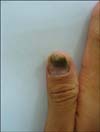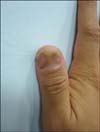Abstract
Green nail syndrome (chromonychia) is a nail disorder characterized by onycholysis and green-black discoloration of the nail bed. This condition is often associated with chronic paronychia. Pseudomonas aeruginosa is the most commonly identified organism in cultures from the affected area. Despite the various treatment options available, removal of the nail is still necessary in many cases. A 35-year-old man presented with dark-greenish discoloration of the nail plate and onycholysis on the left thumbnail. He had been treated with oral antifungal and antibiotic agents for several months; however, the lesion showed no improvement. The diagnosis of green nail syndrome was established after a positive bacterial culture, and on the basis of the antibiotic sensitivity test result, tobramycin eye drop (Tobrex®) was then prescribed. Three weeks later, the nail discoloration almost vanished but the onycholysis remained. Herein, we recommend the application of tobramycin eye drop as an easy and safe treatment option for green nail syndrome.
Green nail syndrome (chromonychia) is a nail disorder characterized by onycholysis and green-black discoloration of the nail bed. Pseudomonas aeruginosa is the most commonly identified organism in cultures from the affected area1,2. Patients usually have a history of long duration of exposure to water or moist conditions, providing an ideal condition for the growth of P. aeruginosa, which is unable to colonize dry environments. Although various treatment options are available, treatment is always challenging and often refractory. This patient with green nail syndrome experienced a dramatic improvement by using tobramycin eye drop. Hence, we recommend the application of tobramycin eye drop as an easy and safe treatment option for green nail syndrome.
An otherwise healthy 35-year-old man presented with onycholysis of the middle to distal part of the nail of the left thumb along with dark-greenish discoloration in the separated portion of the nail. He remembered that the lesion was persistent and had been present for more than a year. He was an office worker and denied any history of trauma. He used to go swimming as a hobby. Although he had been treated with an oral antifungal agent (itraconazole, 200 mg/d) and an oral antibiotic (levofloxacin, 200 mg/d) for several weeks at another dermatologic clinic, the skin lesion showed no improvement. Physical examination of the left thumbnail revealed dark-greenish pigmentation and onycholysis (Fig. 1). Neither paronychia nor eczematous lesion was found around the affected nail. The nails of the other fingers and toes were grossly normal in appearance.
Direct light microscopy of a sample from the clipped nail debridement was negative for fungal hyphae or spores. A bacterial and fungal culture was performed on the sample taken from the middle portion of the nail, and P. aeruginosa was identified. A sensitivity test was also performed, and the organism showed sensitivity to a few antibiotic agents, including tobramycin. Hence, a diagnosis of pseudomonal green nail syndrome was established and tobramycin eye drop (3 mg/ml, Tobrex®; Alcon, Australia) was prescribed. Because there was a considerable crack between the nail bed and plate, we did not perform any kind of mechanical preparation such as nail grinding or resurfacing. The patient was instructed to apply the medication onto the area of nail separation that was located distally, twice a day. After 3 weeks, the pigmentation vanished and only the onycholysis remained (Fig. 2; photograph taken 8 weeks after treatment).
Green nail syndrome (chromonychia) is a nail disorder characterized by greenish discoloration of the nail with onycholysis. The disease is occasionally accompanied by paronychia of the adjacent skin. P. aeruginosa is known as a causative organism1,2,3. This organism is a gram-negative bacillus that can cause localized cutaneous infection to serious life-threatening systemic diseases4. Infections in healthy individuals are not usual. Sites of maceration, trauma, or foreign bodies in the skin may serve as portals of entry for the organism. Pseudomonas infection may produce characteristic cutaneous lesions involving the nails, toe webs, and hair follicles2.
The green-black discoloration of the nail is due to pyocyanin, an antibiotic pigment produced by the Gram-negative P. aeruginosa. Like our patient, affected patients often have a history of long duration of exposure to water or moist conditions, providing an ideal condition for growth of P. aeruginosa, which is unable to colonize dry environments. Other predisposing factors are microtrauma, onychotillomania, and rarely, certain nail disorders such as psoriasis5.
Green nail syndrome may be treated singly or in combination with antiseptics, antibiotics, and sometimes, surgical removal of the involved nail. Antiseptics that can be used include chlorhexidine, 1% acetic acid, and 0.1% octenidine dihydrochloride solution2,6, which show strong microbicidal activity against various bacteria including P. aeruginosa. However, the recommended practice of a few minutes of soaking several times a day may cause irritation of the affected skin and may lead to harmful effects or toxicity to the adjacent skin.
On the other hand, P. aeruginosa is naturally resistant to a wide range of antibiotics. In addition, it may develop additional resistance after an unsuccessful antibiotic treatment through the modification of porin. Therefore, antibiotic treatment should be initiated after a laboratory test for antibiotic sensitivity has been performed. Antibiotics that have activity against P. aeruginosa include aminoglycosides (gentamicin, amikacin, tobramycin), quinolones (ciprofloxacin, levofloxacin), certain cephalosporins (ceftazidime, cefepime, cefoperazone), carbapenems (imipenem, meropenem), antipseudomonal penicillins (piperacillin, ticarcillin), and others7. However, most of the antibiotics that have antipseudomonal activity are used intravenously. Of the oral medications available, ofloxacin is commonly used.
In infective nail diseases, topical therapy is desirable because it avoids the adverse effects associated with systemic therapy. However, systemic therapy is still the mainstay of treatment owing to the higher concentration of therapeutic agent in the lesion and the poor permeability of the nail plate to topically applied drugs8,9. Various researches have been focused on improving transungual permeability by means of chemical treatment, penetration enhancers, and mechanical and physical methods9. In the present case, there were some obstacles in prescribing oral medication. First, on the basis of the sensitivity test result, ofloxacin, levofloxacin, and trimethoprim-sulfamethoxazole were the only medications taken orally. As mentioned above, the lesion showed no improvement despite the patient having taken 200 mg per day of levofloxacin for several weeks. Second, the patient was reluctant to take medications orally for the disease.
Tobramycin belongs to the aminoglycoside group of antibiotics, and it is indicated for the treatment of bacterial infections such as septicemia; meningitis; lower respiratory tract infection; intra-abdominal infection;and skin infection caused by P. aeruginosa, Klebsiella species, Enterobacter species, Escherichia coli, and other organisms10. It is available as an injection, nebulized solution, ophthalmic ointment, and solution. Treatment of the nail is challenging because the usual drug preparations sometimes could not reach the affected site. However, as the affected lesion functioned like a dead space and was a moist environment, we thought that the eye drop solution could easily percolate into the area of discoloration. Another consideration was the low concentration of the antibiotic agent in the eye drop (3 mg/ml). However, the outcome was satisfactory. The patient applied the eye drop twice a day without any inconvenience and had no adverse effect. We could attest that bacterial colonies may be effectively suppressed with low concentrations of the antibiotic agent. On the basis of our experience with the successful treatment of green nail syndrome by using tobramycin eye drop, we believe that tobramycin eye drop is a safe, welltolerated, effective therapeutic option for the treatment of green nail syndrome caused by P. aeruginosa.
Figures and Tables
References
1. James WD, Berger TG, Elston DM, Odom RB. Andrews' diseases of the skin: clinical dermatology. 10th ed. Philadelphia: Saunders Elsevier;2006.
2. Cohen MS, Rutala WA, Weber DJ. Gram-negative coccal and bacillary infections. In : Goldsmith LA, Katz SI, Gilchrest BA, Paller AS, Leffell DJ, Wolff K, editors. Fitzpatrick's dermatology in general medicine. 8th ed. New York: Mc-Graw-Hill;2012. p. 2183–2186.
3. Greene SL, Su WP, Muller SA. Pseudomonas aeruginosa infections of the skin. Am Fam Physician. 1984; 29:193–200.
4. Wu DC, Chan WW, Metelitsa AI, Fiorillo L, Lin AN. Pseudomonas skin infection: clinical features, epidemiology, and management. Am J Clin Dermatol. 2011; 12:157–169.
5. Agger WA, Mardan A. Pseudomonas aeruginosa infections of intact skin. Clin Infect Dis. 1995; 20:302–308.

6. Rigopoulos D, Rallis E, Gregoriou S, Larios G, Belyayeva Y, Gkouvi K, et al. Treatment of pseudomonas nail infections with 0.1% octenidine dihydrochloride solution. Dermatology. 2009; 218:67–68.

8. Murdan S. Enhancing the nail permeability of topically applied drugs. Expert Opin Drug Deliv. 2008; 5:1267–1282.

9. Shivakumar HN, Juluri A, Desai BG, Murthy SN. Ungual and transungual drug delivery. Drug Dev Ind Pharm. 2012; 38:901–911.

10. Brogden RN, Pinder RM, Sawyer PR, Speight TM, Avery GS. Tobramycin: a review of its antibacterial and pharmacokinetic properties and therapeutic use. Drugs. 1976; 12:166–200.




 PDF
PDF ePub
ePub Citation
Citation Print
Print




 XML Download
XML Download